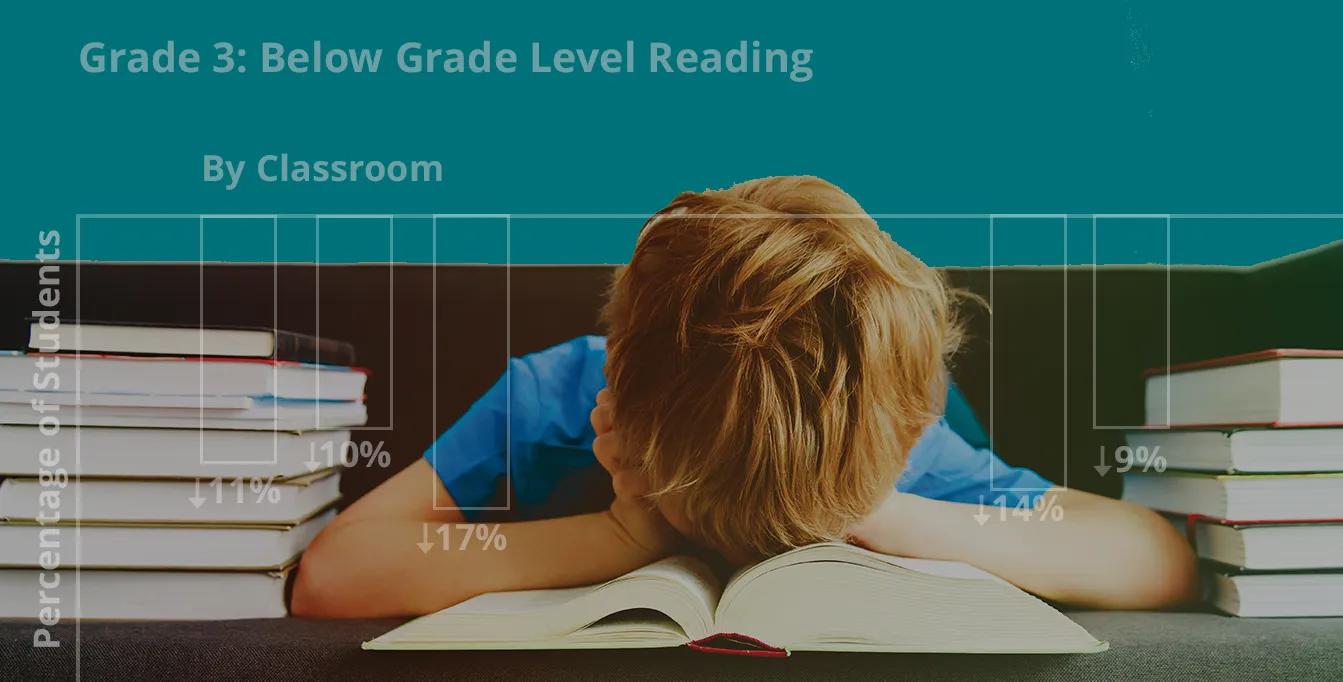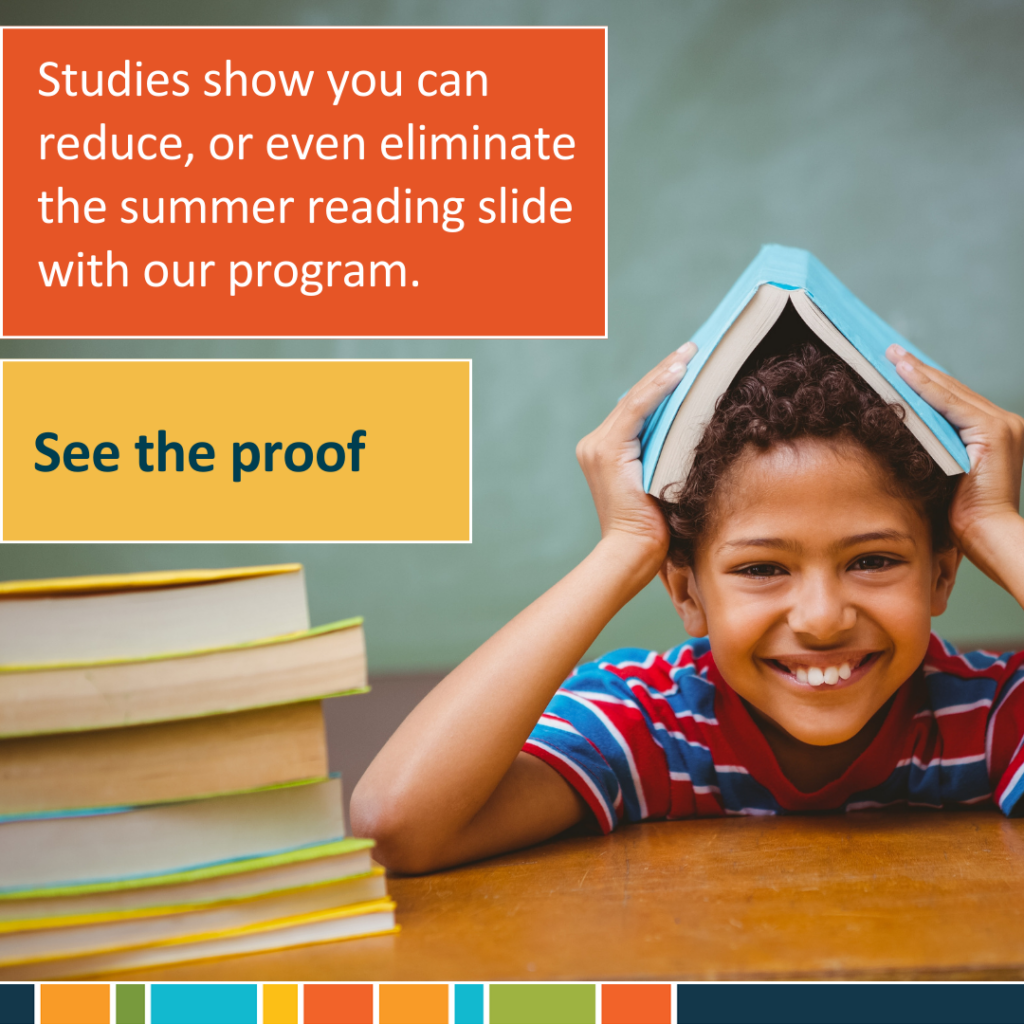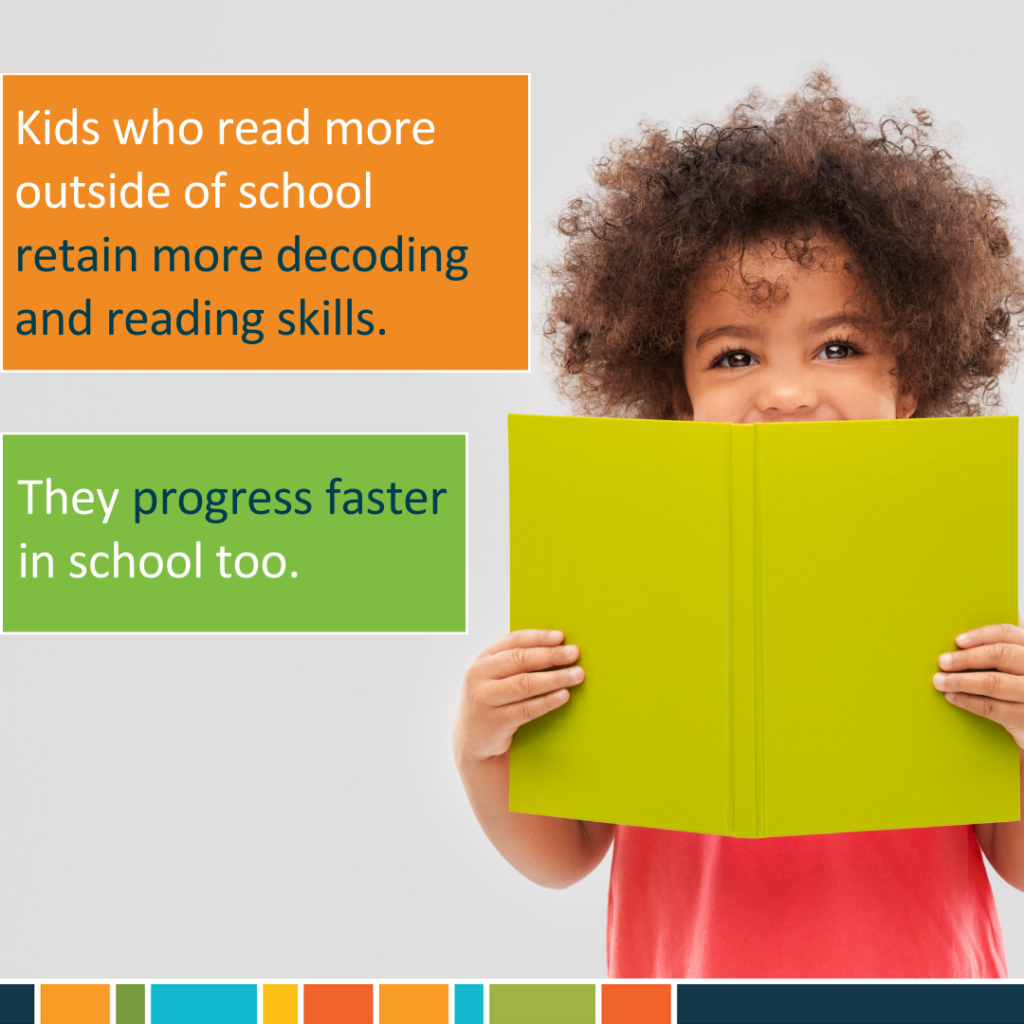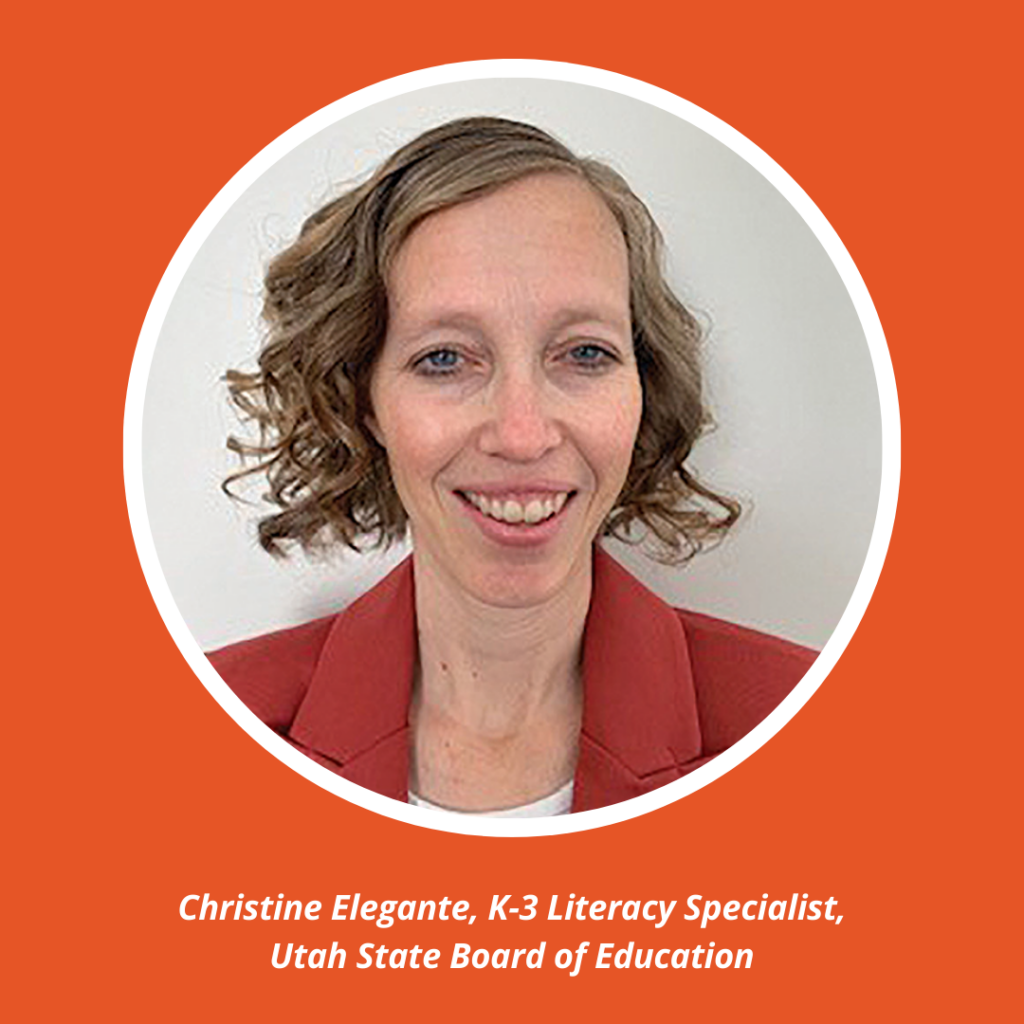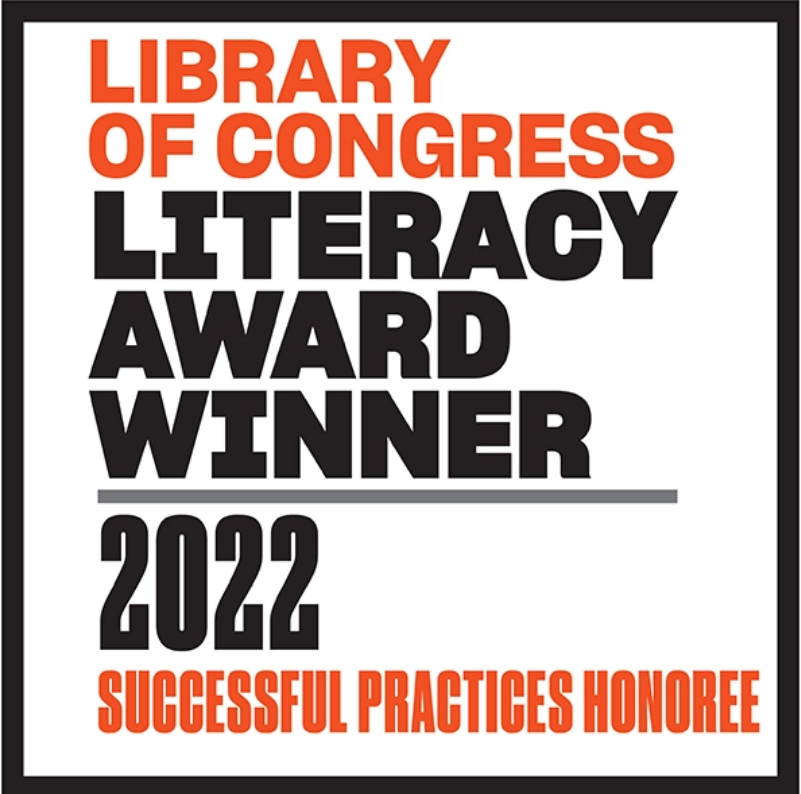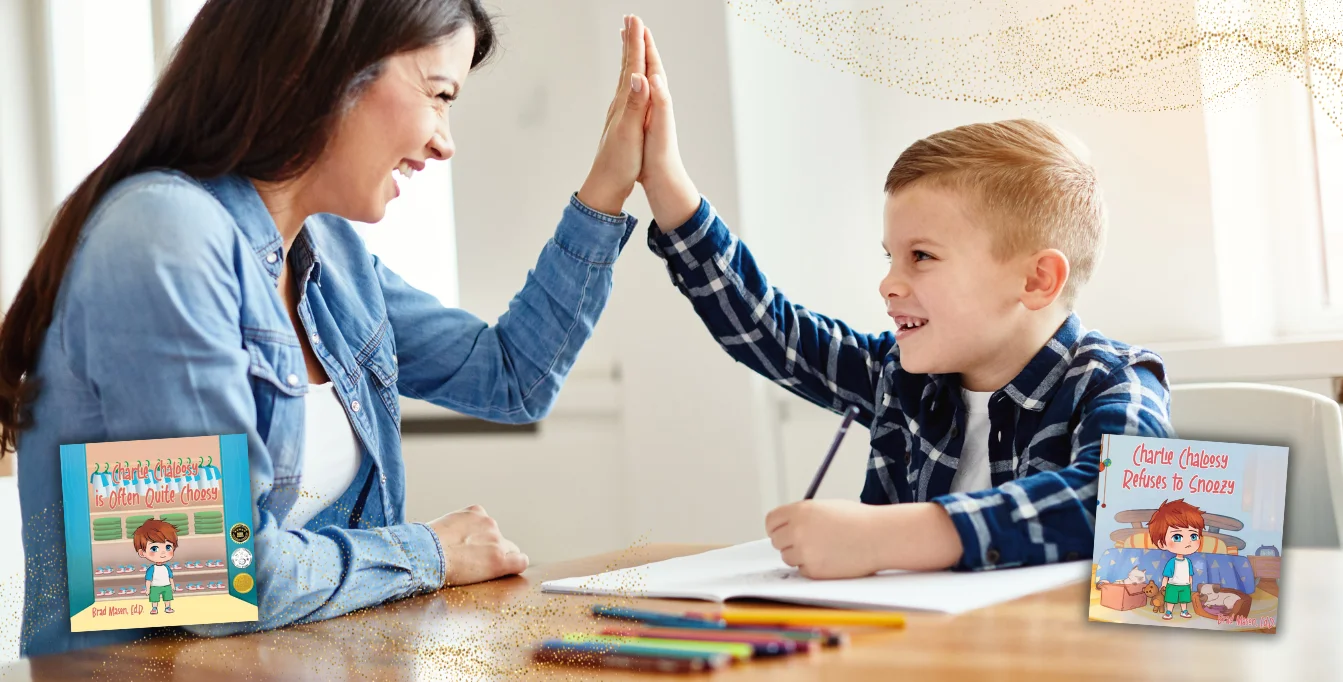Educators need fresh ideas, tools, and resources, as well as innovative ways to combat learning loss and, more specifically, reading loss. This guide is for educators, school district administrators, families, and community leaders, delving into how to define learning loss in relation to reading loss, what experts believe causes it, its impact on individuals and society, and strategies to address it.
This guide aims to facilitate discussions on early childhood literacy challenges and provides actionable steps for educators, schools, and districts. By sharing this information with students’ caregivers and the community at large, we can foster a more engaged community, emphasizing the collective responsibility to boost elementary reading proficiency and subsequently improve outcomes in our neighborhoods, towns, cities, and states.
Who will benefit from this guide?
If you’re looking for new ideas to accelerate improvement in reading and you want those ideas to speed up the learning process, then you’re in the right place, especially if you’re an educator, literacy advocate, or caregiver. It’s a valuable resource designed not only to assist you but also to be shared with colleagues, families, and the wider community.
Navigating the complex subject of elementary learning loss
Reading loss, or learning loss, has proven to be a sticky challenge, and despite the dedicated and vigilant efforts of educators around the country, it’s not improving. It’s actually getting worse.
Don’t get us wrong — educators are doing everything within their power. We know because we work with them every day. However, societal and environmental forces have worked to diminish the success of most educational initiatives.
And to be frank, learning loss puts our kids in danger.
So, why is this, and what do we mean by danger? This guide will answer these question and more.
Put A Stopper In The Summer Slide
👉 Kids Read Now’s in-home, independent reading program has solved the summer reading slide. In fact, independent university research states Kids Read Now is proven to “eradicate the summer slide”!
Ready to talk about your school?
This guide navigates the complex and multidimensional subject of reading loss (aka learning loss) as it relates to students in the early years from PreK through fifth grade. From this guide, you can expect relevant, tailored information about:
- Understanding PreK-5 reading loss in more detail, including how it’s defined and measured and how it predicts adult illiteracy
- Specific causes of early learning loss, beyond just blaming the pandemic
- Ways in which learning loss hinders students’ academic and personal development, their professional future, and how those outcomes affect our society at large
- Actionable techniques that are proven to mitigate PreK-5 reading loss, addressing existing problems that require immediate attention
- The critical role of caregivers in avoiding reading loss from the start, plus how to get them to participate
- Resources to help prevent reading loss altogether, including the potential of technology
- How schools, libraries, families, and community organizations can work together to address learning loss
This guide arms you with actionable, research-based techniques and resources to combat PreK-5 learning loss. In fact, there’s something for everyone:
| Educators: | |
| Research-based insights that reflect the science of reading Examples of how to optimize your Multi-Tiered Systems of Support Community Engagement Tips plus access to a Community Engagement Kit Tons of links to literacy resources | |
| Caregivers/Parents: | |
| Specific advice to engage their children in literacy conversations Tips for optimizing home and school environments Ways to avoid the infamous “summer slide” | |
| Community Members: | |
| Collaborative learning opportunities Technology resources Access to evidence-based materials that supplement traditional instruction |
We share your vision that every child in your school, district, state — and our country — has the mindset and tools they need to become skilled readers before fourth grade.
Like you, we know that success in early literacy cements a strong foundation for success in all facets of life. We believe this guide is a valuable addition to your toolbox that will aid in your mission to improve outcomes across the board.
Confronting the Crisis of Learning Loss
With no time to waste, let’s get right into it. This guide establishes a common definition of “reading loss,” used interchangeably with “learning loss.”
How do we define learning loss?
Whether you’re a teacher, administrator, literacy coach, or curriculum director, you know what learning loss looks like in your classrooms. Faces of real children flash through your mind, and you can hear their young voices breaking as they struggle to read aloud. These students are the heart of our mission.
But for now, try to zoom out a little and view learning loss on a larger scale. (Oops, sorry — didn’t mean to alarm you. There will be no Zoom meetings to sit through on our account!)
We define learning loss using research
As with any educational endeavor, peeling back the layers of PreK-5 learning loss requires analysis of relevant, up-to-date research.
To measure reading loss, we must consider that this phenomenon occurs across disparate districts and populations in all 50 states. As a canvas for comparison, this guide references evidence from the National Assessment of Educational Progress (NAEP), a battery of tests designed to yield “consistent, reliable, complete, and accurate indicators of education status and trends.”
Fortunately, NAEP (aka The Nation’s Report Card) is a “trusted yardstick for U.S. student achievement.” In fact, NAEP and the National Center for Education Statistics (NCES), its federally-mandated administering department, serve as the primary source of K-12 data for the U.S. Department of Education, U.S. Congress, the states, other education policymakers, practitioners, data users, and the public. NAEP and NCES analyze data, describe trends, and offer general advice to education leaders on how to mitigate system-wide issues.
The cut scores on NAEP’s reading test correspond to specific reading behaviors that tend to develop along a continuum. We can say a 4th grader deemed “proficient” in one state has about the same knowledge and skills as a same-aged student in a different state. This aggregate measure gives a picture of the scope of learning loss in the U.S.
“Kids Read Now offers consistent and replicable positive impacts and is a model that can be scaled.”
Dr. Borman led research into the effects of Kids Read Now. Dr. Borman is a leading education researcher, methodologies, and policy analyst with a focus on educational outcomes, education policy, and education inequality.
We define learning loss without overstating the role of the pandemic
Conversations about learning loss in recent years tend to jump quickly to COVID-19, but educators are acutely aware that PreK-5 learning loss has plagued American schools well before the pandemic struck.
Consider this fact:
In 2019, only 35% of fourth-grade students were reading at or above the proficient level. Put another way, almost two-thirds of 9-year-old children struggled to read, and by that time, it was too late for prevention.
Enter COVID-19. Nearly everyone lost more ground.
Once the dust settled, the consensus was that school-aged children lost, on average, slightly more than one-third of a school year’s progress. NCES Commissioner Peggy G. Carr said that the crisis “laid bare an opportunity gap that has long existed,” noting that recovery takes more than returning to the “pre-pandemic status quo.”
In some ways, centering the pandemic in discussions of reading loss dubiously disregards other causes. The pandemic has thankfully wound down, but the barriers to achievement that have haunted schools for decades are more pronounced than ever.
Barriers to achievement that continue to challenge our students and schools:
- poverty
- poor mental health
- low engagement
- homelessness
- disconnected caregivers/parents
- and many, many more.
As you can see, reading loss is not just a pandemic problem. Educators, administrators, and curriculum directors are acutely aware of students’ widespread struggles to read before, during, and after COVID-19.
We define learning loss in terms of core standards
The phrase “reading loss” suggests a deviation from typical or healthy performance. In other words, reading loss means a student’s reading ability is below the benchmark of proficiency.
To understand why and how students are reading “below proficiency,” we need to know the expectations for “proficient” readers. What exactly should young students know and be able to do?
For the most widely accepted answer, look to the Common Core State Standards (CCSS).
The Common Core’s skill-based standards for subject domains at each grade establish high expectations empirically shown to support “college and career readiness.” The creators defined reading success for 12th graders by their ability to qualify for entry-level college courses or job-training programs without the need for reading remediation.
That bar does not seem too high, right?
Then, Core writers worked backwards, grade by grade, to determine where the youngest learners needed to begin if they were to achieve graduation goals. These early standards are, in fact, rigorous, yet children are entering school increasingly less prepared to meet them.
While PreK-5 students aren’t yet directly preparing for college or the workforce, it’s important to remember the profound effect early literacy has on their academic, personal, and professional futures.
Four Fast Facts About The Common Core For Easy Reference | |
| WHO | Question: Who crafted the Common Core Standards? Answer: A task force of 60 business and education leaders from 3 nonprofits, 2 major teachers’ unions, and national organizations who represent teachers. |
| WHAT | Question: What are the Common Core Standards? Answer: A detailed list of knowledge and specific skills deemed important for success in English and math for each grade level. |
| WHEN | Question: When were the Common Core Standards released? Answer: The task force released them in June of 2010, and they are still used today. |
| WHERE | Question: Where are the Common Core Standards used? Answer: Adopted almost everywhere in the U.S. — 43 states, Washington D.C., and 2 territories. |
What is the state of learning loss today?
Keeping your lens wide, let’s examine the current trends in elementary reading loss and how they compare over time. You know the history, but how does that compare to today’s post-pandemic reality?
The data do not look good.
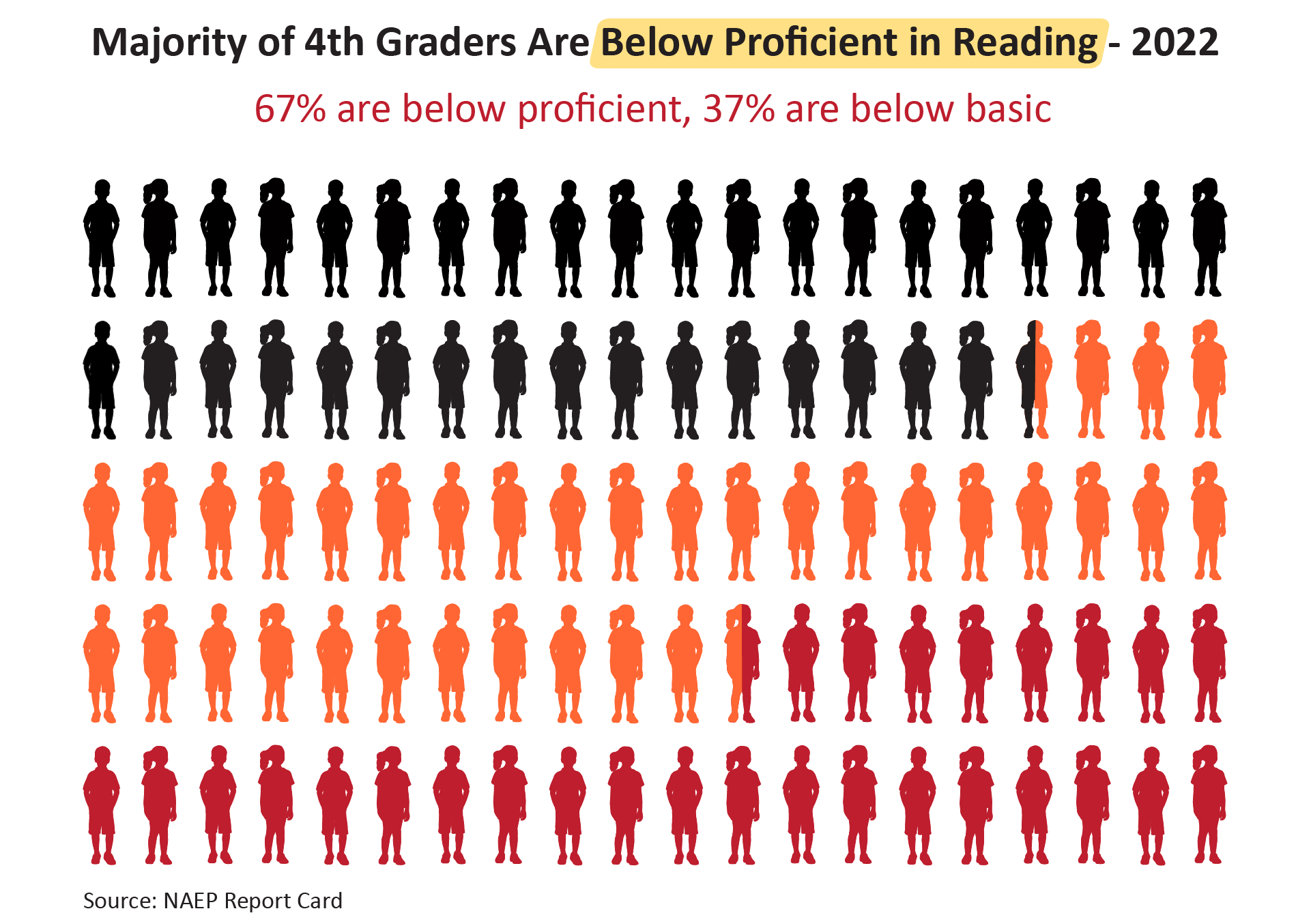
As you can see in the graphic above, a whopping 67% of fourth graders were below the “Proficient” achievement level in 2022. This means they aren’t reading at grade level. What effect does this have on them in school? There is a significant effect. Every month of every year in school, the effect of their lack of proficiency is compounded. They fall further and further behind as they are asked to read at the next level, and the next level, and on it goes.
Even more startling, half of those struggling fourth graders scored below NAEP’s “Basic” achievement level, meaning they haven’t mastered foundational skills.
So, what does “Basic” and “Proficient” fourth-grade reading look like?
NAEP achievement level: “Proficient”:
Scores in this band represent solid academic performance. Students performing at this level are competent with grade-level knowledge and analytical skills and have demonstrated they can apply them to real-world situations.
In NAEP achievement level “Basic”:
Students whose scores meet the Basic but not the Proficient level have only partial mastery of prerequisites that are fundamental for the NAEP “Proficient” level.
To be “Basic”, Students must be able to…
- Recognize word meanings in the context of the reading passage
- Find evidence in the text
- Choose descriptive words for feelings
Prerequisites to “NAEP Basic” (Without the following prerequisite foundational skills, a student’s reading ability isn’t strong enough to be measured on the fourth-grade assessment.)
To meet the prerequisites for the Basic level, students must be able to…
- Generalize about characters and plot
- Restate a character’s motive in a story
- Recognize character traits
- Understand basic cause and effect
- Identify a text’s main idea and details
- Form and support an opinion
- Make a basic inference
- Recall literal plot points
If you’re a reader, that sounds easy. But for the two-thirds of 9-year-olds who struggle to merely decode the words in a passage, the subsequent tasks are nearly impossible to complete in the time allotted for the assessment.
Poor word recognition? Poor comprehension?
Without accurate, fluent reading, comprehension breaks down. So does self-esteem, as well as any joy in reading.
Perhaps, then, it’s not as surprising to see reading scores flatline. There has been little change over the past thirty years.
Let that sink in. Thirty years.
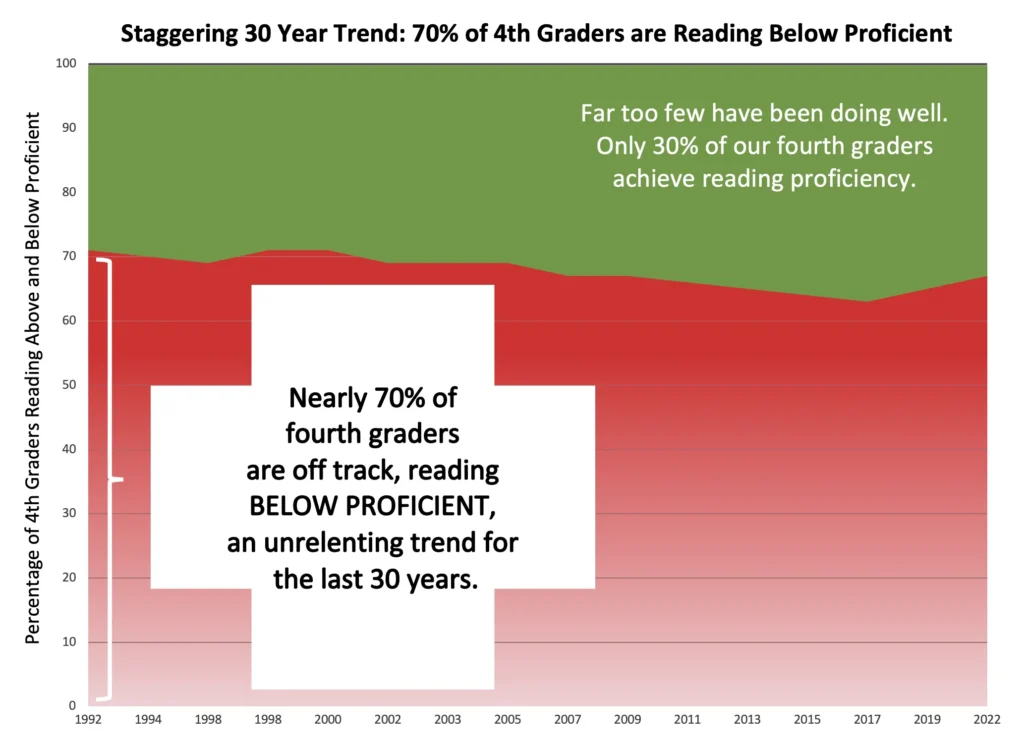
In three decades of tireless effort from educators and legislators at the local, state, and federal levels, when it comes to reading, it appears like nothing has changed. From the graphic above you can see that nearly 70% of fourth graders have been off track, reading below proficient for the past 30 years.
But we know a lot has changed. It’s just that there’s been no uplift in impact when viewed over time. In fact, 2022’s average reading score is exactly the same as in 1992.
There’s something else going on — or not going on.
What will you change this year to end the trend of PreK-5 reading loss?
If you’re ready to make a difference, augment your existing curriculum, and get your students practicing their reading outside of school time, then Kids Read Now is ready to help. Our supplemental, in-home, independent reading program is research-based and proven to work.
Let’s zoom back in and look deeper at fourth-grade reading statistics.
Reading loss ramps up at a critical age
What’s alarming educators, legislators, and parents today is the pattern of decline in reading scores since the start of the COVID-19 pandemic. So while the trendline looks flat over 30 years, the portion between 2020-2022 shows literacy scores have plummeted — fast.
⚠️ Whether students scored in the highest percentile, the lowest, or somewhere in the middle, all groups lost ground on the 2022 NAEP reading test.
Sadly, for those kids who can least afford it, learning loss was even worse.
When scores for 9-year-olds are ranked by percentile, it illuminates a disturbing trend: high-achievers lost a little, and low-achievers lost a lot. For students reading in the 25th percentile and below, the decline is the steepest and most dangerous.
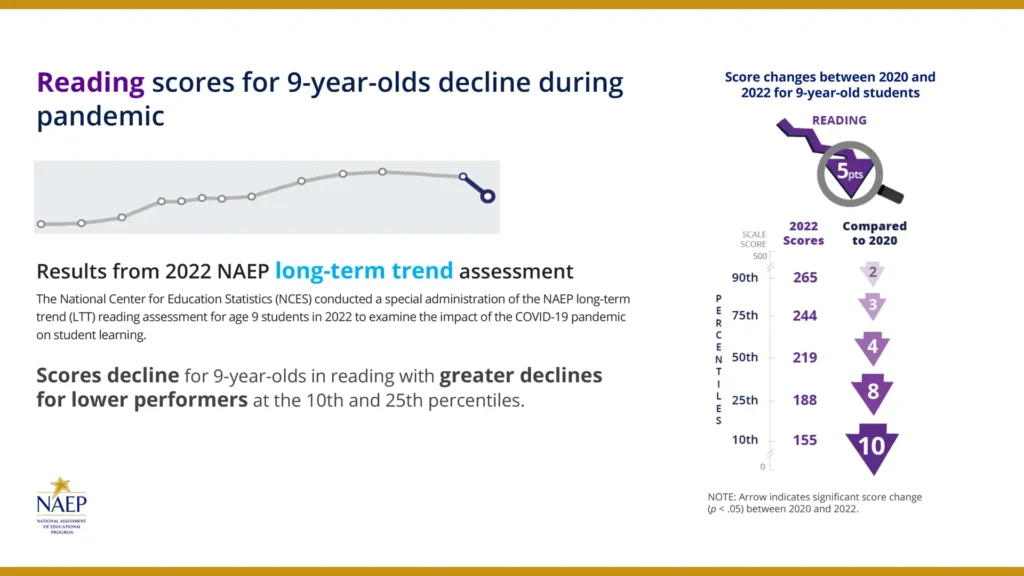
Why is this considered an urgent call to action?
Because this rapid decline happened in just two years.
For the 9-year-olds whose scores are represented in NAEP’s results, the window of opportunity to reverse this reading loss has essentially closed. Because odds are, 9-year-olds who can’t read well probably never will.
Isn’t that sad?
Yet the cycle continues. Every year, a new cohort of fourth graders needs help to become proficient readers. What has changed this year, and can it make up the difference?
What would your end-of-year reading scores look like if…
.. your students read 6 to 8 more books outside of school time all year round?
It would be a game-changer.
“We have a high-poverty district, but reading levels for every student who received books [over the summer from Kids Read Now] either stayed the same or went up!”
Exposing the Effects of PreK-5 Learning Loss
The Pervasive Threat of Learning Loss on Society
The school-to-prison pipeline reality
You know all too well that if struggling readers don’t catch up by fourth grade, their chances for success in other ways are severely limited.
But did you know that reading loss is connected to crime?
“The link between academic failure and delinquency, violence, and crime is welded to reading failure. Over 70% of inmates in America’s prisons cannot read above a fourth-grade level.”
United States Department of Justice
| By the Numbers – The Low Literacy Link to Incarceration | |
| 75% | This is the percentage of prison inmates who did not finish high school and/or are considered only functionally literate. |
| ½ | Compared to the prison population, the fraction of American households where adults did not graduate high school. |
| 85% | The percentage of youth offenders who struggle to read. |
| 3x | How much more likely a child who is not reading well by the end of fourth grade is to end up convicted of a crime compared to a proficient reader. |
| 43% | How much less likely incarcerated individuals are to commit future crimes when they participate in correctional education programs. |
| 58% | The percentage of incarcerated individuals who are eligible, qualified, and choose to participate in correctional education programs. |
| 46-51% | The percentage of Americans who earn wages below the poverty level – due in part to an inability to read. |
| Source: Institute of Education Sciences (IES) – https://nces.ed.gov/blogs/Source: ProLiteracy – https://www.proliteracy.org/ | |
The expanding opportunity gap in American education is a leading indicator of academic success and, therefore, often used as a predictor for later incarceration rates. This phenomenon is sometimes called the “school-to-prison pipeline.”
As we know, marginalized populations of students are at significantly higher risk for academic failure from the moment they enter school.
For an understanding of the school-to-prison pipeline, read Kids Read Now’s disquieting yet moving interview with Jimmy Santiago Baca, in which he describes the role of illiteracy on his childhood, and his time in prison:
“One of the disastrous consequences of not having language is that you get absolutely everything wrong. When you can’t read, you have no idea how the world works. You assume so much because you’re living in this isolation of illiteracy.”
– Jimmy Santiago Baca, award-winning poet and author, founder of the nonprofit Cedar Tree, Inc.
Despite institutional barriers to literacy, Mr. Baca taught himself to read, earned his GED, and credits writing with saving his life.
With stakes this high, it’s critical we inspire curiosity and ambition in our struggling students.
Dropping out and entering the cycle of poverty
- Children who are not meeting basic reading levels at the end of third grade are four times more likely to drop out of school than their classmates.
- If those below-proficient third graders are from low-income households, they are 13 times more likely to drop out.
- Even those who earn their GED in prison aren’t any more likely to earn higher wages. – National Bureau of Economic Research
- In 2018, adults with the highest levels of education had three times (3x) the income and employment rate of adults with the least education. – ProLiteracy
During the pandemic, the unemployment rate of adults with less than a high school diploma grew faster and steeper compared to all other education levels. – Congressional Research Service
“Kid Read Now surpassed all expectations by facilitating easy access to books right at students’ doorsteps. This personalized and thoughtful approach not only fosters a love for reading but also instills a sense of ownership and excitement in students.”
Christine Elegante, K-3 Literacy Specialist, Utah State Board of Education
Increased need for long-term government assistance
It’s no individual’s fault that they struggle to read, especially students with structural barriers who suffer disproportionately. The circumstances and the research are against them, and after all, they’re only children.
Tragically, as these below-proficient readers grow up in at-risk environments, they’re more likely to need government assistance to afford food and shelter.
Two-thirds of students who cannot read proficiently by the end of the fourth grade will end up in jail or on welfare. So, it will come as no surprise that the overall cost of illiteracy for taxpayers is ever-increasing.
Illiteracy affects the economy and costs taxpayers
In America, a wealthy developed nation, the cost of the economic gap between rich and poor is illiteracy, instability, insecurity, and a shorter, lower-quality life.
Doesn’t it sound strange to assign a dollar amount to reading ability?
Juvenile delinquency accumulates human capital by increasing “criminal capital” and decreasing “social capital” (for example, the ability to apply for a job).
Let’s consider the following:
| The Cost of Reading Loss in US Dollars | |
| $272,000 | The amount each high school dropout cost the U.S. economy due to lower tax contributions, increased criminal activity, and more reliance on Medicaid, Medicare, and welfare in 2017. |
| $1.3-2.3 trillion | GDP boost if the US had closed the gap and matched other top-performing countries in 2008, making reading loss more costly on the economy than the 2008 recession. |
| $200 billion | Allocation by the federal government to K-12 schooling, of which just a small portion has reached students, and parents report uneven access to benefits |
| 10 | The number of mental healthcare providers a county could add to reduce the social cost of juvenile arrests by 2.3% to 2.6%. |
| $70 million | Loss incurred by the US healthcare industry because of the low literacy rates of our population. |
| $2.2 trillion | Additional amount of annual income the US would generate by bringing all adults to the equivalent of a sixth grade reading level. |
| 10% | How much the US GDP would increase if all adults in the country were brought to the equivalent of a sixth grade reading level. |
| Source: Institute of Education Sciences (IES) – https://nces.ed.gov/Source National Bureau of Economic Research (NBER) – https://www.nber.org/researchSource: McKinsey and Company | |
Learning loss harms academic achievement in unexpected ways
Reading is not just a subject; it’s the essential tool that enables learning across all subjects. As children progress through school, they move from “learning to read” to “reading to learn.” This transition happens around the third grade.
Children who experience reading loss are at a distinct disadvantage when it comes to pursuing higher education and career options. The National Bureau of Economic Research finds a strong correlation between early literacy skills and later academic success, as well as long-term career outcomes.
If children aren’t reading proficiently by the end of third grade, they are less likely to perform well in high school, reducing their chances of going to college and limiting their future employment opportunities.
Illiteracy is linked to poor mental health and increased suicide-related behaviors
It is disheartening to accept the impact of early literacy, or lack thereof, on students’ mental health throughout school and into adulthood.
The Centers for Disease Control and Prevention (CDC) identifies these negative outcomes as potential effects of poor mental health in adolescents:
- Health risks, such as diabetes
- Unstable or unsafe behaviors, like illicit substance use
- Risky sexual behavior and unintended pregnancy
- Truancy and dropping out
How can schools even begin to address the harrowing mental health crisis harming their students?
Fortunately, the CDC also offers proven ways to positively impact mental health, as well as other health risks. Here’s what schools can do:
Health illiteracy and ongoing threats
Increased spending associated with low health literacy costs the US economy up to $238 billion every year, or 17 percent of all personal healthcare expenditures.
As with literacy in general, disparities in health literacy disproportionately affect vulnerable populations, including:
- Older adults
- Those with limited English proficiency
- Populations with lower incomes/socioeconomic status
- People with lower educational attainment
- Medically under-served people
Common health risks of populations with low health literacy include:
- Diabetes
- Hypertension
- Memory loss (high school graduates were 2-3x less likely to lose memory in their 70s-80s)
- Cognitive decline
- Smoking-related diseases
With the use of evidence-based research, developing effective and efficient interventions for lower-health-literacy populations can resolve health disparities and inequities.
💡 Bonus for educators and caregivers! Researchers note that teaching reading skills is one of the best ways to save an aging brain. "Carlson is running a study called the Experience Corps Trial, in which older men and women volunteer to teach reading skills to kindergarten through third graders in Baltimore City Schools. Using brain-imaging studies, Carlson and her colleagues have shown that after just a few months, people who volunteer show beneficial changes in their brains similar to those that other research teams have seen with exercise.” - Science Direct
Depressing effect on mindset and low self-esteem
How well a student reads is not as important as that student’s belief about their ability to read. Their beliefs and their abilities are mutually dependent.
Like the proverbial chicken and the egg, it’s hard to tell whether a negative belief about their identity as a reader is a cause or symptom of repeated failure. Therefore, why not address both?
The best teachers have growth mindsets and teach their students to consciously think in healthy, positive terms that emphasize the importance of learning concepts rather than achieving a particular result.
For example, instead of saying or thinking, “I’m terrible at reading,” after making a mistake, children with growth mindsets reframe the event as a learning opportunity, thinking, “What strategies can I apply?” or “I don’t know that word…yet.”
Have you heard any of these negative beliefs expressed by students?
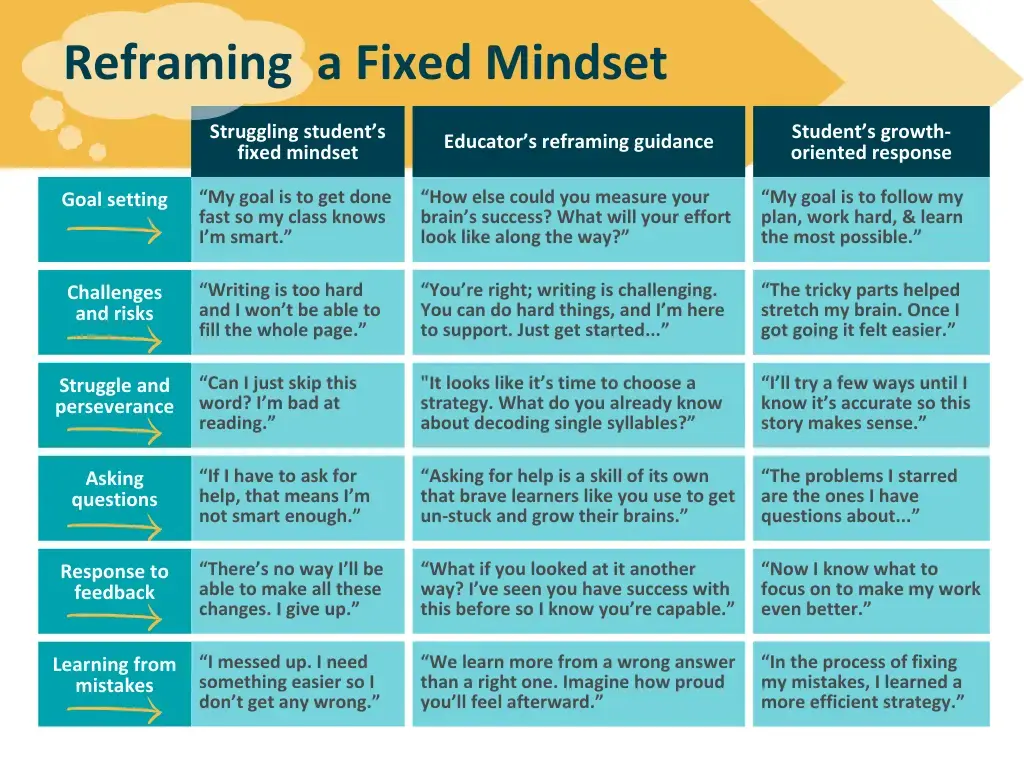
Some schools call this “the power of yet.”
Sources: Mindset Works – https://www.mindsetworks.com/science | National Library of Medicine – https://pubmed.ncbi.nlm.nih.gov
| The Magic of Mindsets | |
| 🌱 | Growth mindsets reduce stereotype threat (confirming a negative stereotype about yourself). This is especially consequential for girls, Latinx students, Black students, or students from low socioeconomic backgrounds. |
| 🌱 | Growth mindset interventions are proven to improve academic outcomes. |
| 🌱 | In classrooms where the teacher attributes intelligence to “effort” as opposed to “ability,” low-achieving students at the beginning of the year ended the year as medium- or high-achievers. |
| 🌱 | Messages about attribution theory and malleable intelligence have also been shown to improve standardized test performance. |
| 🌱 | People with growth mindsets tend to have higher self-esteem and fewer depressive symptoms. |
| 🌱 | Teaching incremental theory (belief in the potential for personal change) reduced aggression and bullying in adolescents. |
Underdeveloped language skills break down communication
Clear communication — the ability to listen, understand, and clearly articulate thoughts and feelings — is critical to establishing healthy relationships.
Although non-educators might not associate reading text in a book with hearing and speaking, the processes are implicitly tied. As you know, we are born pre-programmed for the cognitive process of language.
This is the point where two big buzzwords come up… Phonological awareness. Phonemic awareness.
Before we ever understand letters or words, our brain is developing phonological awareness, or the ability to manipulate parts of phrases, sentences, and words in spoken language.
Eventually, we’re able to break language down into its smallest units, called phonemes. The ability to manipulate these individual sounds is one of the few true prerequisites to literacy.
When the brain’s phonological processor and phonemic awareness skills are sufficiently developed, we’re ready to begin to learn to read.
Check out this visual representation of how reading happens in the brain, beginning with language sounds in the phonological processor.
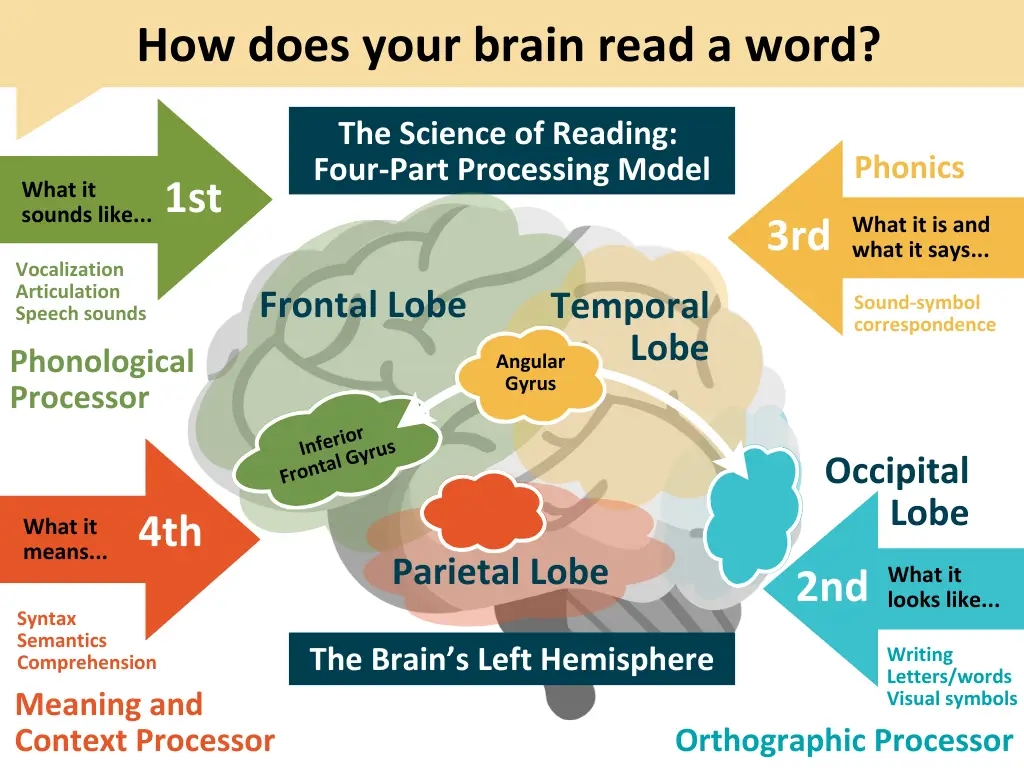
It stands to reason that reading loss can also break down communication skills. Individuals who struggle with language lack deep bonds and report feelings of loneliness and isolation.
As educators, caregivers, and literacy advocates, we have a responsibility to our children and to society. We have the potential to stop students from entering traumatic cycles that result from reading loss.
As the saying goes, “Knowing the problem is half the solution.” Only by exploring the causes behind learning loss can we start to design practical solutions.
Causes of PreK-5 Learning Loss
What causes students to struggle to learn to read? When it comes to reading loss in the PreK-5 years, there are many contributing factors that begin well before a child has formal schooling.
While science has given us insight into how typically-developing students learn to read and write, each student is different and brings a unique set of biological and environmental experiences into the classroom.
It can feel overwhelming to parse out causes and correlations.
But fear not!
We’ve compiled these common contributing factors (supported by research) to help bolster an understanding of reading loss.
Professor John Hattie’s Visible Learning meta-analyses measure the positive, negative, and neutral impact of hundreds of factors on children’s education. All educators, at home and school, can use this information to gain insight into factors influencing their students and to choose strategies with the highest effect sizes that make the most difference.
Insufficient instructional time devoted to reading
One of the primary causes of reading loss is insufficient instructional time devoted to reading.
According to a report from The Education Trust, a mere 10 to 15 minutes a day in kindergarten classes are spent on reading instruction. Children, particularly those struggling, require much more exposure and repetition to acquire and solidify reading skills.
✅ Getting kids to spend those extra minutes of reading practice is what Kids Read Now does, with a great deal of help from caregivers, of course!
Kids Read Now has an award-winning program that engages parents in helping their child sit down to read or be read to. Here’s why it works.
Library of Congress Literacy Award Winner.
Recognized for our implementation of highly successful practices in literacy promotion, including Innovation, Sustainability, Replicability, Measurable Results, and Evidence-Based Practices.
Schools that use the Kids Read Now in-home, independent reading program know why it is so successful at reducing reading gaps, particularly the summer reading slide.
Limited vocabulary development
You’ve likely heard about the “30-million word gap,” a phrase from a 1992 study that’s been cited tens of thousands of times since. These researchers contended that by age three, children from “welfare” families were exposed to 30 million fewer words than children from “professional” families.
Educators, caregivers, and administrators might be familiar with the notion that affluent students start school with larger vocabularies. But can something as complex as vocabulary really be explained by income alone?
Of course not!
More recent studies of language comprehension aim to eliminate the racial bias of the original study by taking into account cultural practices like turn-taking, bystander speech, and whether adults address children directly. They found the vocabulary discrepancy along socioeconomic lines is closer to 4 million words or less by age four.
Whatever the size of the discrepancy, the stakes are high for the most vulnerable populations. For that reason, sociolinguistic experts now suggest vocabulary not be framed as a “gap” at all.
By assuming certain populations have less knowledge of word meanings, schools have been inadvertently using biased deficit models that harm the very students they’re trying to help – those with low SES or culturally diverse language practices, English learners, immigrants, and/or nonwhite students.
Not only that, but the Eurocentric nature of US schools requires standard academic English to be considered successful. That’s a double whammy for structurally disadvantaged students from non-European backgrounds.
So, with all these “gaps,” what can we agree on?
Vocabulary knowledge is integral to reading comprehension, and children start school with a wide range of known words.
Those from low-income households or whose caregivers talk less tend to have smaller vocabularies, though not always for the reasons we assume.
From the very beginning, some students’ reading journeys are behind their peers who are White, middle- or upper-class, and/or native English speakers.
Both school and home environments hold tremendous potential to build vocabulary knowledge by reading and talking with kids.
Difficulty with foundational skills
The inability to master foundational skills such as phonemic awareness, phonics, fluency, and comprehension can also contribute to reading loss. While learning to read doesn’t happen completely linearly, these foundational skills tend to develop on a continuum.
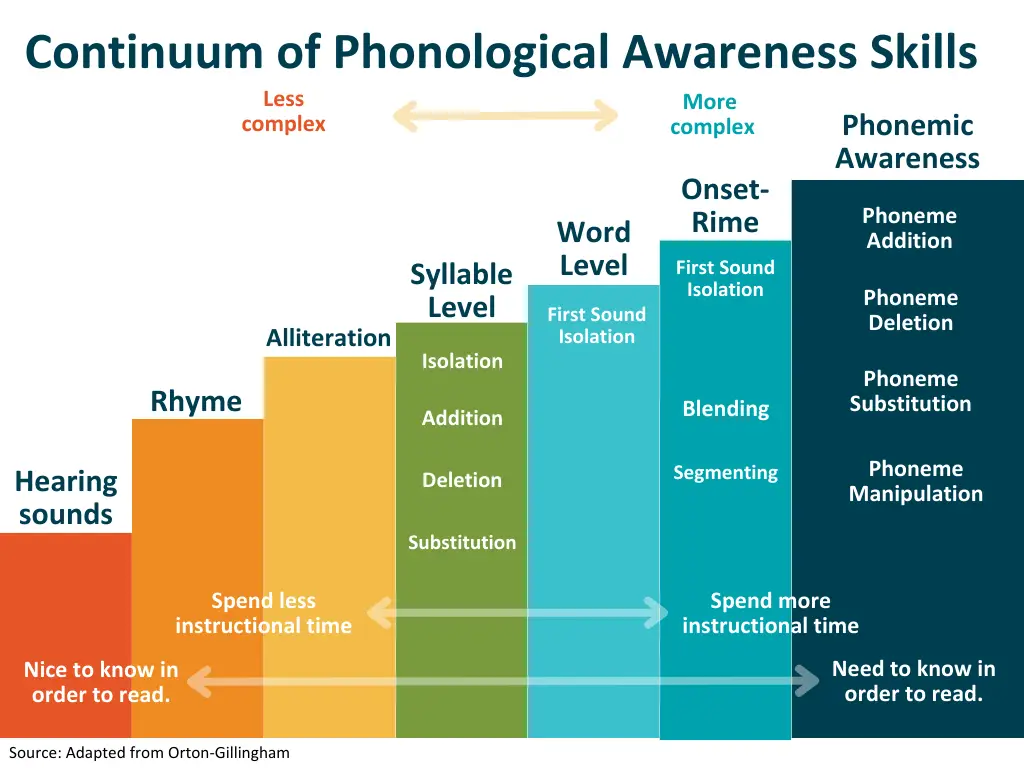
If children struggle with these skills, they are likely to encounter difficulties as reading demands increase in later grades.
Learning disabilities or cognitive challenges
Children with learning disabilities (LDs) or cognitive challenges are also more susceptible to reading loss.
In particular, speech and language challenges can significantly impact the process of learning to read. That’s not terribly surprising, considering word recognition requires matching sounds to print.
Reading difficulties are often misdiagnosed, overdiagnosed, or not diagnosed at all. Literacy — and literacy loss — is so multifaceted that it’s difficult even for psychologists, physicians, and other professionals to pinpoint the cause of difficulty.
What may be surprising, though, is the sheer scope of language difficulties. Longitudinal studies of reading disabilities, like those published in Reading Psychology, reveal that an overwhelming 70% of kids who struggled to read had a history of language difficulties.
Consider the Four-Part Processing Model that the Science of Reading uses to explain how the brain learns to read. Without a smooth connection between the brain’s phonological (sound) and orthographic (print) processors, the transition from listening and speaking to reading and writing can be long and difficult.
Perhaps most widespread is dyslexia, a learning disability affecting reading that impacts up to 20% of the population, according to the International Dyslexia Association. There is no cure for dyslexia, so early identification and skilled teaching is key.
Be sure to set the record straight for families who might believe common myths about dyslexia.
Dyslexia is not merely reading backwards or b/d reversals. Outside of special education, many more people in the general population experience symptoms of dyslexia that look like lack of fluency, low accuracy, inconsistent spelling, limited writing, or misidentifying similar words.
Here's what's often overlooked: Individuals with LDs or cognitive challenges are prone to stress, poor self-image, underestimating their abilities, and labeling themselves “dumb.” Children with these struggles require additional support to keep pace with their peers in academics and social-emotional development.
Lack of engagement and motivation
If children do not see the relevance of the material, or if it does not align with their personal interests, their motivation to read can quickly dwindle.
As John Hattie’s Visible Learning meta-analyses found, student engagement carries an above-average effect size of .56 and has a significant positive impact on achievement.
The link between reading proficiency, engagement, and motivation is pretty clear. Students who achieve reading proficiency actively engage in the act of reading, and their motivation to do so goes beyond being a being “told to do so”, aka homework. These students choose to read more, even if only a little bit more, and that choice is a huge step in their journey to becoming a practiced reader, a proficient reader.
👉 This is where the Kids Read Now program prevails. For over 10 years, we’ve been singularly focused on what works to get kids to want to read outside of school time because the old adage is true that “practice makes perfect,” or better said today, “practice makes proficient”.
✅ The Kids Read Now program is a recipe, a beautiful combination of behavioral psychology, expertise in product distribution, communications technology, parent engagement, and at the core, a thoughtfully curated list of children’s books that pique the curiosity and interest of a diverse student population.
✅ The Kids Read Now program has been proven in multiple independent studies to be a replicable and scalable solution that gets even the most challenging-to-reach students reading at home.
“The scheduled mailed books and ease of reporting them could not be any more convenient.
It kept my child engaged, excited for the next delivery and motivated to check off another book to reach her goal.”
Jeannie, Parent, Lee County, Florida

Post-pandemic reading loss across the board
The COVID-19 pandemic has had a notable impact on all aspects of life, not the least of which is education. School closures and shifts to remote learning disrupted traditional education models, and many students faced difficulties in adapting to changes.
According to McKinsey & Company, students in the United States could lose, on average, up to nine months of learning by the end of the academic year due to the pandemic. For students of color, the learning loss could be even higher, averaging up to 12 months.
Though COVID-19 has undoubtedly set PreK-5 students behind, it’s important to remember that the issue of reading loss predates the pandemic.
If there is a silver lining, it’s perhaps that quarantining and remote learning freed up time to simply read for pleasure. Reading for the joy of it highly impacts achievement in literacy, vocabulary, and even math, as found by a pre-pandemic longitudinal study published in 2014.
Sadly, without our vigilant efforts and constant attention, reading loss will continue after the pandemic, with mounting challenges.
Having delved into the causes of PreK-5 reading loss, it’s clear that this is a multifaceted issue requiring a comprehensive approach.
Intentionality is key. The data paints a bleak picture, but there is hope.
Addressing PreK-5 reading loss requires us to weave together data, best practices, collaboration, and technology. With these threads, we can create a resilient tapestry of literacy education.
In the following sections, we will discuss specific factors contributing to PreK-5 reading loss and, most importantly, what we can do to address and prevent it.
In this next section, we’ll uncover effective techniques, strategies, and resources that can make this difference and turn the tables on PreK-5 reading loss.
Our goal is to provide you, as educators, curriculum directors, and administrators, with the knowledge and resources necessary to reverse the trend and ensure every child in your district reaches their full potential.
Together, we will tailor the present to build a future where every child has the chance to succeed. Every single one.
Addressing Learning Loss with Intentional Action
“An ounce of action is worth a ton of theory.”
Ralph Waldo Emerson
In this next section, we’ll apply a lens of novelty as we cover techniques, strategies, and resources that can make a difference and help you turn the tables on PreK-5 reading loss.
Get distracted students refocused & learning
Reignite learning. Sign up to get these 10 quickfire academic activities that combine learning with fun. Quick and easy to weave into any lesson.
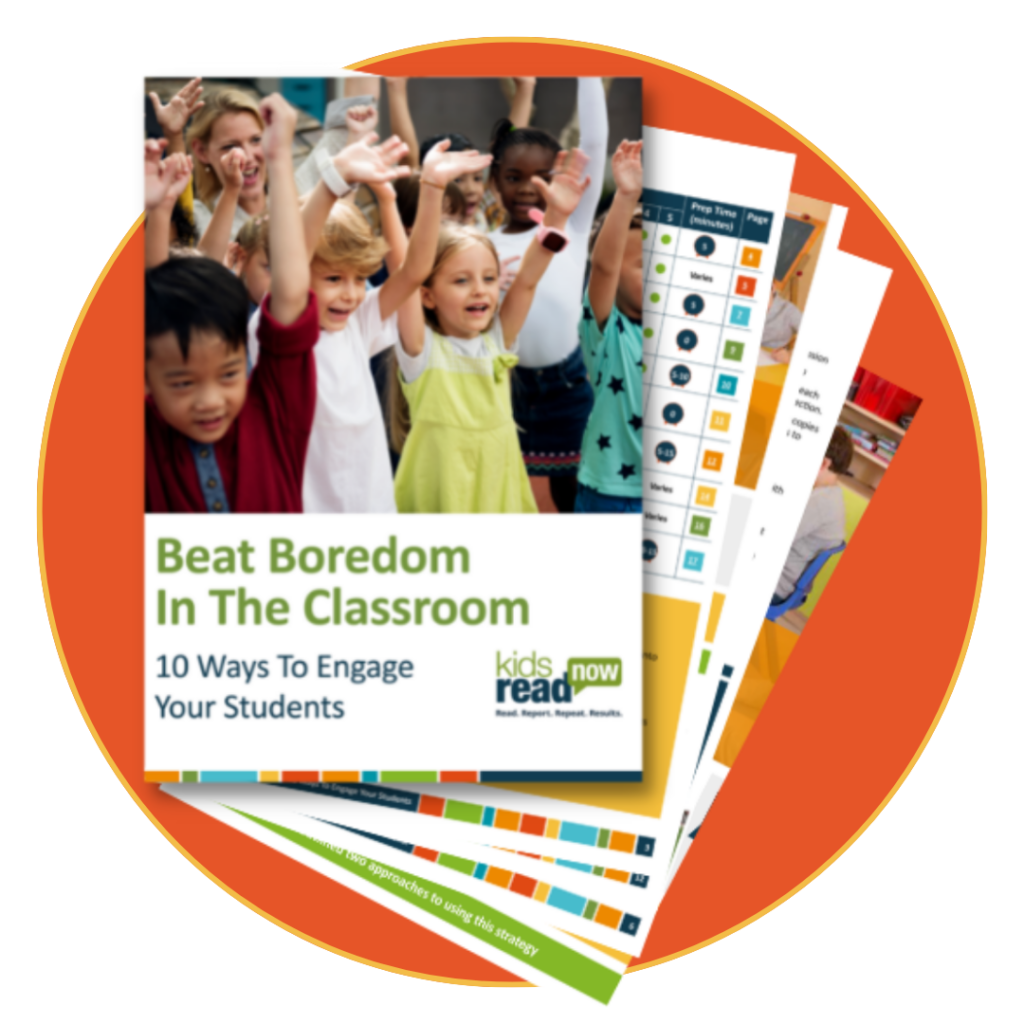
Partnerships between parents and schools
The first teachers in a child’s life are almost always their parents, guardians, or caregivers.
Early relationships with trusted adults provide a baby’s initial exposure to the innate human function of language.
They say babies are sponges, and in no way is that more true than with language. Immediately, the part of their brain that’s wired for language begins absorbing sounds, intonation, and recognizing voices.
For decades, research has shown that parent-child reading activities contribute significantly to a child’s language development and readiness for school. In short, children who are read to at home have a literary leg up when they start school.
An act as simple as seeing a caregiver read a book can inspire a child to pick up their own.
Despite their irreplaceable role, caregiver involvement alone can’t prevent or remediate reading loss. They need special knowledge and flexible materials to effectively support their children’s early literacy development. That’s where educators can make a difference.
5 ways schools can build strong family partnerships:
- Send books home.
- Schedule regular book check-outs from the school library.
- Provide and pre-teach simple learning games and activities for students to take home and teach to a family member.
- Consider parents’ linguistic and cultural needs in verbal and written communication.
- Enlist the help of Kids Read Now to get your students reading books with the participation of caregivers.
Simple actions like reading aloud daily, fostering a print-rich environment, and talking about books can make a significant difference.
The program that stops the infamous summer slide
If your child(ren) or students have not experienced the summer slide, consider yourself lucky.
The “summer slide” — reading loss that occurs over every summer break — is a challenge that we must tackle. An effective, evidence-based resource to combat this is the Kids Read Now PreK-5 in-home reading program.
“The effects of the summer slide can potentially be devastating for at-risk and struggling readers,” said Barb Lurie, former educator who co-founded Kids Read Now with her husband, Leib Lurie.
“Low-income students are typically an entire year behind in reading by fourth grade, with two-thirds of the this gap attributed to the summer slide.”
– Barb Lurie, Cofounder of Kids Read Now & 30-year educator.
Kids Read Now sends books to students’ homes throughout the summer, encouraging continued reading practice and caregiver involvement, thereby mitigating the summer slide.
Supported by case studies, Kids Read Now’s summer program has been successful in preventing and reversing the summer slide for over ten years.
Is this your school? Are these your kids?
High-income students with access to books are going to make great gains. However accelerated growth for low-income students is achievable, too.
Harnessing technology to address learning loss
In our rapidly evolving digital landscape, technology offers myriad tools to enhance literacy education. Online assessment tools and interactive platforms have the power to captivate even the hardest-to-reach learners. Yet, while digital tools can be a motivator, there’s a hidden cost to leaning too heavily on them. Technology presents both a promising solution and a set of challenges to consider.
| The Potential of Technology in Early Reading | Challenges of Technology in Early Reading |
| 1. Interactive E-books: Digital books with animations, sound effects, and clickable glossaries. | 1. Over-reliance on Technology: Excessive use can lead to dependency. |
| 2. Digital Reading Platforms: These offer leveled readers and quizzes. | 2. Distractions: Multimedia elements can divert attention from core content. |
| 3. Gamified Learning Apps: Apps like ABCmouse and Reading Eggs engage learners. | 3. Overemphasis on Gamification: Focus might shift from learning to rewards. |
| 4. Speech Recognition Tools: Assist students with pronunciation and fluency. | 4. Lack of Physical Interaction: Misses the tactile experience of a physical book. |
| 5. Augmented Reality (AR) Reading Apps: Transform stories, making reading interactive. | 5. Equity Issues: Not all students have equal access to technology. |
| 6. Personalized Learning Platforms: Adjust to each student’s level. | 6. Data Privacy Concerns: Raises security and privacy issues. |
| 7. Virtual Reality (VR) Storytelling: Immersive VR environments enhance comprehension. | 7. Technical Issues: Glitches can interrupt learning. |
| 8. Online Reading Challenges: Motivate students to read more. | 8. Cost: Technology tools can be expensive. |
| 9. Digital Story Creation Tools: Develop both reading and writing skills. | 9. Potential for Ineffective Use: Might not be used to its full potential. |
| 10. Online Tutoring and Reading Support: Connect students with reading specialists. | 10. Reduced Social Interaction: This might limit group activities and discussions. |
| 11. Parental Engagement Tools: Keep parents in the loop. | 11. Screen Time Concerns: Prolonged exposure can lead to health issues. |
| 12. Professional Development for Teachers: Update educators on reading instruction technology. | 12. Potential for Misinformation: Not all digital content is accurate. |
| 13. Digital Libraries: Provide access to a vast range of digital books. | 13. Dependency on Internet Connectivity: Stable internet is a must. |
| 14. Assistive Technology: Make reading accessible for students with disabilities. | 14. Reduced Development of Fine Motor Skills: Touchscreens offer different interactions. |
| 15. Feedback and Analytics: Offer insights into student performance. | 15. Lack of Personal Touch: Automated feedback might lack nuance. |
Amid these potentials and challenges, the Kids Read Now program stands out. It seamlessly integrates some of the advantages of technology while championing the timeless value of physical books. This dual approach not only reaches out to those learners who often seem just beyond our grasp but also inspires them to read more, fortifying their focus skills.
📙 For schools partnering with Kids Read Now, there's an added layer of insight. An online portal is provided, acting as a window into the reading habits of students. This portal offers specific insights, such as the book titles each student selected, the date each book was mailed, and feedback from students or caregivers about the books. This data, available at both individual and aggregate levels, can be instrumental in tailoring instruction to meet the unique needs of each student.
But the offerings of Kids Read Now don’t stop there. Families are granted a desktop portal and a specially designed mobile app (significantly valuable for populations without internet access at home.) This app is more than just a digital tool; it’s a bridge to deeper comprehension. Tailored questions, aligned with the Science of Reading, pave the way for enriching discussions about each book. And, for those who are not native to the English language, these questions can be accessed in the family’s native language, ensuring every conversation is both meaningful and authentic. It’s heartening to note that 79% of caregivers, whose children are enveloped in the Kids Read Now experience, endorse our program!
The Timeless Value of Physical Books
While the digital realm offers much, the tangible benefits of traditional, physical books cannot be overshadowed:
- Reduced Digital Distractions: Physical books provide a sanctuary from the constant pings and notifications of the digital world, allowing for pure, undisturbed immersion.
- Promotion of Deep Reading: They foster a state of focused and immersive reading, which is pivotal for comprehension and retention.
- Tactile Experience: The simple joys of holding a book, flipping its pages, and feeling its weight anchor readers to the present moment.
- Combatting Attention Issues: In an era where attention spans are dwindling, physical books offer a respite, sharpening reading and focusing abilities.
In essence, while technology is a formidable ally, it’s the harmonious blend of the digital with the tangible that truly makes the difference. With the Kids Read Now program at the forefront, bridging the gap between the two worlds, the horizon of literacy education looks brighter than ever.
Community collaboration: It takes a village
While we have a massive problem to solve, we’re also equipped with a massive number of resources that already exist. Students win when schools, libraries, and community organizations work together to create a culture of literacy with opportunities for all types of readers to develop their literacy skills.
Leveraging local libraries
When districts partner with local libraries, it opens the door to a wide range of quality children’s literature, technology, and resources for all ages. Libraries are already popular—78% of American adults say they’ve been to a library at some point, and 76% believe libraries serve their community well, according to a study by Pew Research Center Study.
Libraries tend to organize reading programs and events that motivate children to read and expose them to new genres and authors, often by appealing to personal interests and empowering students with choice.
Community organizations can also play a significant role. For example, literacy nonprofits can provide tutoring and mentorship, donate books, and run reading programs, like Kids Read Now’s Summer Reading Program. Businesses can sponsor literacy events or donate resources. Local colleges and universities often provide volunteers or organize literacy projects.
Such collaborative efforts create a literary culture in a supportive environment where community members have access to the resources and opportunities they need to become strong readers and lifelong learners.
Collaborative opportunities to strengthen connections
Finally, collaboration among PreK-5 teachers, librarians, instructional coaches, curriculum advisers, administrators, and community organizations can create a strong support network to address reading loss.
The fight against PreK-5 learning loss is not a solitary one. It is a collective responsibility, and together, we can make a difference.
Under the umbrella of a Multi-Tiered System of Supports
This one’s got it all: collaboration with colleagues, systematic guideposts for prevention and early identification, interventions, data-driven decision-making.
Here, you’ll see how the pieces of the reading loss puzzle fit smoothly into the MTSS framework. Keep in mind, you may experience your system differently based on the population of students you serve, state and district requirements, and a school’s principal’s leadership.
That’s the beauty of MTSS: its flexibility to meet the needs of any school.
Techniques for preventing learning loss, or reading loss, need to be incorporated into systems everywhere. According to a report by The Learning Policy Institute, MTSS can contribute to increased reading achievement when implemented properly.
A highly effective MTSS in a PreK-5 setting is built from the following tiered protocols:
Tier 1: Universal/Core (~ 80% of students)
- For 43 states, the core curriculum is the Common Core — both federal and state — and core instructional minutes are mandated for each subject.
- Formative and summative assessments identify when to move on as a class, which students can use acceleration/extension, and which students are not yet meeting the standard.
- As a rule of thumb, when formative assessments show that 60% of the group or more don’t understand or aren’t meeting a learning target, initiate a whole-class intervention.
- Read The Secret Strength of Universal Design for Learning (UDL) to reframe your thinking about core instruction and get some fresh ideas on implementation.
Tier 2: Supplemental/Targeted (~ 15% of students)
- Title I interventions
- Explicit Instruction Model
- Small group (research suggests no more than five students)
- Pull-out of “push in” to the general education classroom
- Foundational skills like phonemic awareness and phonics
- Multimodal, sensory, and repeated exposures
Tier 3: Intensive (~ 5% of students)
- Title I or other interventionists
- Special Education (”Resource”) in or outside of the general education classroom
- Very small group or one-on-one setting
- More supplemental time
Evidence-based instruction and intervention
Effective use of data is crucial in addressing reading loss. Regular assessments can help educators monitor student progress, identify students at risk of reading loss, and implement timely and targeted interventions.
You rarely see teachers just sitting down and crunching numbers. So, what does the effective use of data look like in practice?
Give students a voice in assessment and goal-setting
Involve students in setting, tracking, and meeting their own goals.
Tip: If the reading loss is significant enough to affect confidence — maybe they’re monitored on a probe from a lower grade level, or if the end-of-year goal is dauntingly far away — focus on small, incremental goals. As the student experiences success, goals could become more and more ambitious.
Start with small goals they can meet fairly easily in order to build confidence, and they’ll be more willing to brave a larger goal later.
They might not make it, but does their trend line show accelerated growth? Do you know the effectiveness of your intervention? Celebrate narrowing the gap!
Once you’ve collected it with the enthusiastic help of the students, actually use all that progress monitoring data to inform instruction.
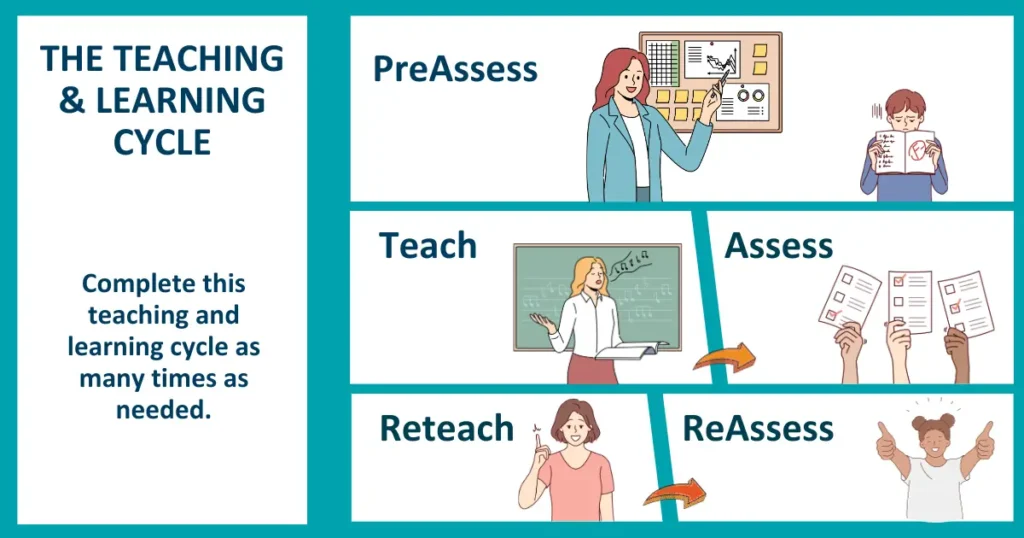
Complete this teaching and learning cycle as many times as needed: pre-assess → teach → assess → reteach → reassess
Several data collection and analysis tools can support educators in this process. Even better — your assessments can be built into your MTSS framework.
Assessment Tools To Consider:
- Phonological awareness diagnostics (no print)
- Phonemic awareness diagnostics (single sounds)
- Phonics diagnostics (single- and/or multi-syllable levels)
- Benchmark testing/universal screening
- Pre- and post-unit tests (summative)
- Exit slips (formative)
- Voice recordings at home or in class (performative)
- Nonsense word reading (phonics – decoding)
- Decoding closed syllables (listen for automatic blending)
- Dictated spelling (phonics – encoding)
- Fluency measures of correct words per minute
- Cold, warm, and hot reading
Instructional strategies that actually work
Not all teaching is considered equal. But how do we determine the right instructional strategies? It’s a science — and an art.
The Science: Instructional strategies must match…
- Students – Consider your specific students’ age, prior knowledge, attention span, vocabulary, background experiences, and learning styles.
- Objectives – What’s the desired outcome of the lesson? What content or skill should students learn, and to what extent?
- Context – How you teach will depend on the group size, time, available materials, technology, curricula, support, and other resources.
- Research – Choose only evidence-based strategies that are proven to increase achievement. The higher the effect size, the better!
The Art: Instructional strategies must also be…
- Flexible – Ensure your lesson won’t get derailed by changes in context, like absent students, a last-minute assembly, or a recess incident that requires your attention.
- Adaptable – You’ll likely need to make changes on the fly based on student responses. Anticipate these adaptations when designing a lesson.
- Interesting – Get creative! Even the driest lesson can be tweaked to reflect what students are interested in. Instead of segmenting “cat,” try “Pete” and bring in the Pete the Cat book you read last week.
- Engaging – Students have to want to participate and might be motivated by hands-on learning, interactive or kinesthetic components, partner work, inquiry, choice, or more.
One crucial strategy for preventing reading loss is to ensure our literacy instruction reflects the most current research, including findings from The Science of Reading.
The Science of Reading is a vast body of research from multiple fields, including cognitive psychology, neuroscience, and linguistics. Its insights can help teachers fine-tune their instructional methods to better support early readers.
We’ve peeled back — perhaps painstakingly — the root causes and cures for the national issue of PreK-5 learning/reading loss. But what if the problem didn’t exist in the first place?
Let’s pivot to prevention.
Prevention, after all, is not reacting to children’s failure after the fact but proactively establishing systems at home and school that work for all students and families. Intentionality is key.
In this final section, we’ll delve into how exactly we can contribute to these preventative systems, enabling a generation of confident, competent readers.
An Ounce of Prevention for PreK-5 Learning Loss
“An ounce of prevention is worth a pound of cure.“
Ben Franklin was referring to house fires when he popularized this proverb, yet the sentiment has become ubiquitous. For educators, caregivers, and literacy advocates, investing in prevention is the best way to snuff out and efficiently “cure” reading loss.
Still, it takes more than an “ounce” to head off a problem as pervasive as reading loss in PreK-5. Along with optimizing what happens on campus, schools must also draw on assets off-campus if they hope to maximize time and resources.
Happily, many schools and districts are sitting on three months of untapped time: summer break. Year after year, we see learning loss when students return to classrooms after their summer break.
And if we can predict it, we can prevent it.
(Check out how Kids Read Now can help your school overcome the summer reading gap.)
Read what one superintendent says in “5 Keys to a Successful Summer Reading Initiative” for details on how Kids Read Now tackles the issue.
Preventing PreK-5 learning loss takes consistency, laser-like focus, and commitment from entire communities. Here, we explore diverse, evidence-based, and holistic approaches to curb reading loss altogether.
With literacy, early birds get the reading worms
The journey to proficient reading begins sooner than we might think. If a child’s educational journey is a tower of blocks, early literacy is the very table on which it’s built. If the blocks are stacked on a table that’s wobbly or missing a leg…
Boom!
The National Institute for Literacy reports that the development of early literacy skills, such as vocabulary, letter knowledge, and phonological awareness, is directly linked to later reading proficiency.
Remediating these skills later can require significantly more time, assessment, and specialized instruction to correct misconceptions and reverse habits — and successes are uncommon.
Understanding the progression of early literacy development allows educators to identify struggling readers quickly and begin the implementation of targeted interventions. In this way, they proactively attack reading loss by explicitly teaching and repeatedly practicing skills
Practice makes habit: Implement daily literacy routines
Setting daily routines around literacy at school and at home can lay the foundation for reading success. Routines, whether it’s dedicated reading time or interactive read-aloud sessions, create an environment where reading is valued and becomes a habit.
Get high-quality books in the hands of kids
Access to high-quality books is essential. Children need a wide variety of texts that not only match their reading levels but also cater to their interests and cultural backgrounds. A diverse book collection can engage young readers, encouraging them to explore and enjoy the world of reading. Kids Read Now offers a diverse collection of high-quality books that appeal to today’s students.
Bonus Points: Does it match their interests? Did they choose it themselves? Is it a “just right” text or a familiar read for fluency?
Turn tiered systems into well-oiled machines
There’s just no substitute for a robust schoolwide Multi-Tiered System of Support (MTSS). Its characteristic streamlined procedures prevent any students from falling through the cracks.
In a well-oiled MTSS machine, students aren’t “labeled”; they simply get what they need when and how they need it. Built-in assessments, screeners, and diagnostics identify students at risk for reading loss, as well as those who haven’t yet mastered critical phonics or phonological awareness (PA) skills.
MTSS teams collaboratively decide the best way to provide appropriate supports, considering the whole child and the availability of resources. Then, that student receives supplemental Tier 2 instruction in addition to Tier 1 core instruction, ideally until they are proficient.
Tired yet?
Lucky for educators, caregivers, literacy advocates, and curriculum directors, an MTSS engine can keep itself roaring if fueled by routine assessments, built-in checks for understanding, and data-driven decision-making.
According to the NCES, more than 90% of teachers conduct academic assessments at least once a month, but you could argue most teachers use formative assessments every day.
Stay curious — Do your research
In the last decade or so, advancements in neuroscience, linguistics, and cognitive psychology have provided fascinating insight into how children’s brains work.
What does brain research have to do with PreK-5 reading loss?
Pretty much everything — in a good way.
The findings chart a precise path to proficient reading that could eradicate reading loss if done right.
Forget the pendulum you’ve been hearing about for decades. The science of reading isn’t just another initiative to be supplanted in a few years. PBS News noted many districts are liking the “whole language” or “balanced literacy,”
Regardless of politics and rhetoric, science is now able to provide the most valid and reliable evidence in history about the way in which the brain acquires literacy.
Ongoing studies provide increasingly accurate and detailed information about not only typically developing students but also those with learning disabilities and reading difficulties, such as dyslexia.
With over 30 years of reliable, peer-reviewed studies available, the study of reading has led to the empirical validation of some pedagogy yet rejected the efficacy of other instructional practices.
Considering NAEP found that students taught with research-based instructional methods outperformed their peers by 25%, the stakes are too high to spend time using anything other than what we know works.
And here’s the best part:
The science of reading is proven to work for everyone. Adults and children from marginalized identity groups are pushing for widespread adoption of the science of reading. The NAACP views literacy as a civil rights issue.
When it comes to instruction, “research-based” and “data-driven” aren’t just buzzwords. They’re the gateway to preventing PreK-5 learning loss and disproportionate reading failure from day one.
The potential risks of relying on tradition or instinct to shape pedagogical practices are something we simply cannot afford. PreK-5 reading loss is too pervasive and consequential to resist change or accept complacency.
Leverage the power of parent partnerships
We’ve established PreK-5 reading loss as a grim and far-reaching issue in American schools. But would you believe 92% of parents think their children are reading at grade-level proficiency?
Online parent surveys conducted by Edge Research for Learning Heroes and National PTA reveal a startling disconnect between the actual and perceived realities of reading failure between educational institutions and the families they serve.
In response to this finding, Learning Heroes, a nonprofit that helps parents stay informed about their child’s education, noted that without accurate information, parents can become barriers instead of partners.
Knowing parental involvement is pivotal to reading success; we need to change mindsets from “my kid is fine” to “my kid might need help” to keep everyone engaged.
Still, do parents know how to get engaged?
One effective way parents can support is through programs like Kids Read Now. This program, designed to combat the summer slide, involves parents directly in their children's literacy journey, creating a bridge between home and school.
Provide (worthwhile) professional development for teachers
Just as their student populations are changing, so too do educators need to evolve their beliefs and practices to meet the needs of all students from all backgrounds.
Continuous professional growth will enable them to adapt and respond to the diverse needs of their students.
Our children’s futures are in our hands — let’s make sure we’re armed with the best knowledge to guide them.
Optimize home and school environments for maximum literacy
Now that you’ve trudged through the grim causes and grave effects of reading loss let’s try something more positive:
Imagine a world where all students can read and read proficiently. They lift words off the page as if cracking a code, then make meaning as they tell stories to themselves and others. If it’s hard, they get help. If they still need more support, it’s there. Soon enough, every child from any background experiences their “aha” moment.
Sound too good to be true? It doesn’t have to be.
Classrooms need to promote a positive learning atmosphere that encourages curiosity and a love for reading.
Good news — that begins with you.
Dr. Kamshia Childs, guest author for Kids Read Now’s Latest in Literacy blog, suggests a handy acronym for creating literacy R.I.C.H. environments.
Homes should also support this by providing access to a variety of reading materials and a quiet, comfortable place for reading.
Conclusion
Navigating through this guide, we’ve unraveled the intricate tapestry of reading loss, a challenge that extends beyond classroom walls and into the very heart of our society. The data, especially insights from the National Assessment of Educational Progress (NAEP), paint a picture that’s both concerning and compelling, emphasizing the urgency of our mission.
Yet, amidst these challenges, there's a beacon of hope: the Kids Read Now program. This initiative isn't just about reading; it's about empowering students to take charge of their learning journey, fostering a love for reading, and laying the foundation for lifelong proficiency. Schools that have woven the Kids Read Now program into their curriculum are witnessing the transformative power of independent reading.
As we reflect on the insights and strategies presented in this guide, let’s remember our collective vision: a world where every child, irrespective of their background, achieves reading proficiency by fourth grade. This isn’t just an educational goal; it’s a societal imperative. With tools like Kids Read Now and the collaborative spirit of educators, caregivers, and community members, we’re not just addressing a challenge; we’re shaping the future.
In the grand tapestry of education, every thread counts. Let’s ensure that the narrative of reading loss transforms from a challenge to a story of triumph, collaboration, and hope.
FAQs About Learning Loss
Learning loss, often referred to as reading loss, signifies a deviation from expected reading performance. Using the National Assessment of Educational Progress (NAEP) as a benchmark, reading loss is gauged against specific reading behaviors that develop progressively.
Multiple factors hinder reading achievement, causing learning loss. These include:
Pre-existing Challenges: Even before the pandemic, there was a significant issue with learning loss. In 2019, only 35% of fourth-grade students were reading at or above the proficient level, indicating that almost two-thirds of 9-year-old children struggled with reading.
COVID-19 Pandemic: The pandemic intensified the pre-existing issue of learning loss. With disruptions in traditional education, students lost an average of over a third of a school year’s progress.
Societal and Environmental Forces: Despite the efforts of educators, societal and environmental forces have worked against the success of most educational initiatives, leading to increased learning loss.
Unique Biological and Environmental Experiences: Each student is different and brings a unique set of biological and environmental experiences into the classroom, which can influence their learning trajectory.
Barriers to Achievement: Multiple factors hinder reading achievement, including poverty, mental health challenges, low engagement levels, homelessness, and lack of parental involvement.
Family/Parent/Caregiver Involvement: The first teachers in a child’s life are their parents, guardians, or caregivers. Early relationships with trusted adults provide a child’s initial exposure to language. However, a lack of active involvement in reading activities and discussions can hinder a child’s language development and readiness for formal schooling.
Lack of Access to Resources: Not all students have equal access to educational resources, which can contribute to disparities in learning outcomes.
Instructional Methods: The potential risks of relying solely on tradition or instinct to shape pedagogical practices can lead to gaps in effective reading instruction.
While learning loss existed long before the pandemic, the global crisis exacerbated the issue with school closures, online learning, inconsistent access to resources, and increased stress. School-aged children lost, on average, slightly more than one-third of a school year’s progress. In many cases, structurally disadvantaged students, like those from low-income households, lost a disproportionate amount of learning. It’s possible that the steep decline in NAEP reading scores between 2019 and 2022 can be attributed to the pandemic, at least in part.
Poor word recognition and comprehension can lead to a breakdown in self-esteem and diminish the joy of reading. The goal of reading is to make meaning, to communicate ideas, and to explore the world. Children who cannot lift words off the page are not able to understand these messages, leaving them unable to use reading to navigate all aspects of 21st-century life.
Fourth grade is typically the point in elementary school when children are developmentally ready to shift from learning to read, to reading to learn. Core instruction becomes more comprehension-based, requires deeper thinking, and often no longer explicitly teaches foundational phonics or phonemic awareness skills. NAEP measures reading proficiency for fourth graders nationwide on its annual Reading Assessment, so quite a bit of data exists about readers at this age. Fourth grade has high stakes: If students are not reading proficiently by the end of the fourth grade, they are four times more likely to drop out of school and more likely to be incarcerated as adults.
The Common Core State Standards (CCSS) for Literacy provide a consistent framework that outlines specific literacy skills students should master at each grade level, from kindergarten through twelfth grade. These standards are designed to ensure students are prepared for college and the workforce by the time they graduate from high school. In terms of reading instruction, the CCSS emphasizes the importance of reading complex texts, analytical thinking, and evidence-based responses. Teachers are guided by these standards to structure their lessons and activities in a way that progressively builds students’ reading skills. When it comes to assessment, the CCSS serves as the benchmark against which students’ reading proficiency is measured. Standardized tests aligned with the CCSS evaluate students’ understanding and application of the literacy skills outlined in the standards. These assessments provide educators with valuable data to identify areas of strength and weakness in their instruction, allowing them to tailor their teaching strategies to better meet the needs of their students. In essence, the CCSS for Literacy deeply influences both the content and methods of reading instruction, as well as the tools and criteria used for assessment
To address early learning loss, especially in the context of PreK-5 reading loss, the following strategies and methods can be employed:
Partnerships between Parents and Schools: Recognizing that parents, guardians, or caregivers are often the first teachers in a child’s life, it’s essential to foster strong partnerships between them and schools. Engaging parents in reading activities with their children can significantly contribute to a child’s language development and readiness for formal schooling.
Intentional Action: Addressing learning loss requires more than just understanding its causes; it demands intentional action. Implementing research-based techniques, strategies, and resources can make a significant difference in reversing PreK-5 reading loss.
Leverage the Power of Parent Partnerships: Given the potential disconnect between parents’ perceptions and the actual reading proficiency of their children, it’s crucial to involve parents actively. Schools can provide resources, training, and support to help parents assist their children in their reading journey.
Prevention: Adopting a proactive approach is key. Instead of reacting to children’s reading failures, schools should establish systems that work for all students and families. This involves optimizing both on-campus and off-campus resources and strategies.
Invest in Research-Based Instruction: Emphasizing research-based and data-driven instruction can ensure that students receive the most effective reading education. Moving away from tradition or instinct and relying on proven pedagogical practices can make a significant difference.
Utilize Technology and Off-Campus Assets: Schools can leverage technology and other off-campus resources to supplement and enhance the reading instruction students receive in the classroom.
Personalized Reading Programs: Programs like Kids Read Now, which allow students to select books tailored to their interests and reading level, can be instrumental. Such programs not only provide students with engaging reading material but also involve caregivers in the process, offering guided questions that foster comprehension in alignment with the Science of Reading.
The Kids Read Now program offers a uniquely designed approach to help schools address learning loss through a blend of student choice, behavioral psychology, and direct-to-home delivery. At its core, the program delivers an in-home, independent reading experience ensuring students remain engaged and continue to enhance their reading skills even when they’re not in a classroom setting.
Central to the program is the powerful element of student choice. With the guidance of teacher insights, each student selects books that align with their interests and reading level, making reading time a unique experience tailored specifically for them. Once chosen, these new books are delivered directly to the students’ homes, one at a time, making each arrival an anticipated event. This personalized approach ensures sustained enthusiasm for reading as students eagerly await the delivery of fresh, new books to their homes. Each book, personalized with their name, is theirs to keep forever and becomes more than just a reading task; it’s an exciting event, a personal exploration into the world of stories.
However, the program doesn’t stop at the student; it actively involves caregivers in the journey to reading proficiency. Kids Read Now connects with and encourages caregivers to engage with their child’s independent reading. For each book title, caregivers are provided with guided questions that foster comprehension, aligning with the Science of Reading. These questions are family-friendly and delve into comparisons of text-to-text, text-to-self, and text-to-world, ensuring a deeper understanding and connection to the material.
The results speak for themselves; two independent studies have shown that with Kids Read Now, students gain an additional 2 1/2 months of classroom learning!
The Kids Read Now program actively involves families in their child’s independent reading journey, creating a holistic approach to combat learning loss. Central to this engagement is the direct-to-home delivery of books. As students select titles from a diverse wishlist, these books are sent directly to their homes, turning each delivery into an anticipated family event. But the engagement goes beyond just receiving books. Caregivers are equipped with guided questions that foster comprehension, aligning with the Science of Reading. These questions, which delve into comparisons of text-to-text, text-to-self, and text-to-world, are designed to facilitate deeper discussions between caregivers and students. This not only ensures a deeper understanding of the material but also fosters a shared love for reading. By intertwining the reading experience with family involvement, Kids Read Now transforms independent reading into a collaborative family endeavor.
Schools receive data on the book titles each student selected to read, the date each book was mailed, whether the book was reported as read, and the rating given to that book by students and caregivers. The data can be instrumental in personalizing instruction and gauging students’ interests, and summer data can be used in preparing for the incoming class each fall.
Inspiring Young Authors with Storytelling
Writing on the Heart of a Child When I created the Charlie Chaloosy book series…
Prevent the Summer Slide in Literacy — Starting Right Now
Estimated reading time: 10 minutes Prevent the Summer Slide in Literacy — Starting Right Now!…
Read Across America: Family Engagement to Support Reading Success
Estimated reading time: 7 minutes Celebrate Read Across America with Family Engagement Strategies As we…

